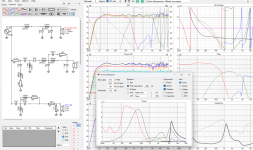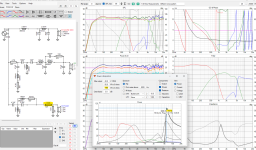I'm no stranger to ensuring electronic components can handle the wattage they see. Actually, a decent part of my job is ensuring every build that goes out the door is safe to run at full load for its required duty cycle.
I do understand that a 100 watt input at 100 can cause a 107 watt dissipation at 1.6 ohm. Lower impedence pulls more power. I get that. What I don't understand is the duty cycle here. Is this resistor, or rather resistors since I'll need a few to handle this, going to see 107 watts for any sort of length of time? Resistors burn up because they get hot. If they are only seeing 107 watts for a split second when the drummer hits a cymbal then do I really need need four 25 watt resistors in series/parallel for this location.
When it says flat, does that insinuate a 100% duty cycle?
In the world I live in we don't rate things for 100% duty cycle if they won't ever see it. The starter motor on your car will see 500 amperes for 2 seconds while the engine fires up. Its duty cycle is super low. That is how it is so small and the wire leading to it is so small. We don't worry about the heat build up because it wouldn't heat up fast enough to burn itself out in its 7 second rated duration of running. It runs for 2 seconds and we assume it has a lot of time to cool off. If we had to build your car for 100% duty cycle on every component then your starter would be the same size as your engine and the wires leading to it would be about 4 inches across. Your car would also be about $6,000 more expensive to produce.
I see the pink noise options drops the wattage every component sees by a factor of about 25. This insinuates a duty cycle of about 5%. Is this about the duty cycle components see?
There is a crest factor component to this and I think 12 db is about correct for most music yet the flat option has this set to 3 db. Maybe I don't understand fully the logic of what is happening here. Music is a complex load.
Does anyone know what the duty cycle of the pink noise is? What is the duty cycle of normal music? Can someone please explain this to me or point me towards a reading that can?
I do understand that a 100 watt input at 100 can cause a 107 watt dissipation at 1.6 ohm. Lower impedence pulls more power. I get that. What I don't understand is the duty cycle here. Is this resistor, or rather resistors since I'll need a few to handle this, going to see 107 watts for any sort of length of time? Resistors burn up because they get hot. If they are only seeing 107 watts for a split second when the drummer hits a cymbal then do I really need need four 25 watt resistors in series/parallel for this location.
When it says flat, does that insinuate a 100% duty cycle?
In the world I live in we don't rate things for 100% duty cycle if they won't ever see it. The starter motor on your car will see 500 amperes for 2 seconds while the engine fires up. Its duty cycle is super low. That is how it is so small and the wire leading to it is so small. We don't worry about the heat build up because it wouldn't heat up fast enough to burn itself out in its 7 second rated duration of running. It runs for 2 seconds and we assume it has a lot of time to cool off. If we had to build your car for 100% duty cycle on every component then your starter would be the same size as your engine and the wires leading to it would be about 4 inches across. Your car would also be about $6,000 more expensive to produce.
I see the pink noise options drops the wattage every component sees by a factor of about 25. This insinuates a duty cycle of about 5%. Is this about the duty cycle components see?
There is a crest factor component to this and I think 12 db is about correct for most music yet the flat option has this set to 3 db. Maybe I don't understand fully the logic of what is happening here. Music is a complex load.
Does anyone know what the duty cycle of the pink noise is? What is the duty cycle of normal music? Can someone please explain this to me or point me towards a reading that can?
Attachments
Last edited:
Since it's appropriate for a calculation to list by default the full power at each frequency, the question of what's real has always come up. The pink noise offering is a step towards something more realistic but mustn't be seen as typical. Knowing what is, is usually a grey area.
Even before this you have to imagine that you won't often see full power at any frequency when wide bandwidth music is playing through an amplifier which can represent it. Further, the power in bands (say we break the spectrum into octaves or less) falls towards higher frequencies, and isn't necessarily the highest at lower frequencies.
It is something you'll want to do on test, to confirm your choices by checking your components after listening to music through them.
A thread of interest is one from the past by member Pano, which shows some good spectrum data for various types of music.
Even before this you have to imagine that you won't often see full power at any frequency when wide bandwidth music is playing through an amplifier which can represent it. Further, the power in bands (say we break the spectrum into octaves or less) falls towards higher frequencies, and isn't necessarily the highest at lower frequencies.
It is something you'll want to do on test, to confirm your choices by checking your components after listening to music through them.
A thread of interest is one from the past by member Pano, which shows some good spectrum data for various types of music.
I thought you might find this interesting. It's the spectral content of music visualized. You can see the tonal balance of different types of music.
The graphs below are FFT analysis of different music genres. The files analyzed for the this test are the average of approximately 112 different recordings in each genre. I averaged those recordings and plotted the spectrum.
Note that the graphs do NOT show how loud the tracks were mastered, because all tracks were normalized before averaging them. That allows for the overlay on one of the plots. The plots just show tonal balance. You...
The graphs below are FFT analysis of different music genres. The files analyzed for the this test are the average of approximately 112 different recordings in each genre. I averaged those recordings and plotted the spectrum.
Note that the graphs do NOT show how loud the tracks were mastered, because all tracks were normalized before averaging them. That allows for the overlay on one of the plots. The plots just show tonal balance. You...
- Pano
- Replies: 89
- Forum: Everything Else
Ok, this is what I suspected.Even before this you have to imagine that you won't often see full power at any frequency when wide bandwidth music is playing through an amplifier which can represent it. Further, the power in bands (say we break the spectrum into octaves or less) falls towards higher frequencies, and isn't necessarily the highest at lower frequencies.
This crossover will be mounted on a wall with the components in free air. I can play music and check the components with my FLIR thermal camera. This should give me some good data that I can share with the group as well as the ability to swap out components if they get too hot.It is something you'll want to do on test, to confirm your choices by checking your components after listening to music through them.
Thanks for that Rayma. This makes more sense and is as I suspected. The higher frequency components see a lower duty cycle load. I suspected this since I often watch music with a spectrogram going and I can watch the music load tonally.
You need to derate by spectrum range and duty cycle.
Example: in a 100W 3-Way system power, the tweeter might receive only 1W average when listen to music at 100W peak.
From some measurements I took here are some examples:
Spectrum distribution: 80% Woofer, 15% Mid and 5% tweeter (depends on the crossover frequencies you choose)
Duty cycle: 20% for the whole spectrum - maybe different for each spectrum range, but I didn't measured it
(sometimes I'm more conservative if the loudspeaker is not for my own use)
For each crossover component, you have to estimate the peak (if magnetic core used) and average current for inductors, capacitors and resistors.
Example: in a 100W 3-Way system power, the tweeter might receive only 1W average when listen to music at 100W peak.
From some measurements I took here are some examples:
Spectrum distribution: 80% Woofer, 15% Mid and 5% tweeter (depends on the crossover frequencies you choose)
Duty cycle: 20% for the whole spectrum - maybe different for each spectrum range, but I didn't measured it
(sometimes I'm more conservative if the loudspeaker is not for my own use)
For each crossover component, you have to estimate the peak (if magnetic core used) and average current for inductors, capacitors and resistors.
Mainly crossover resistors will get warm, and possibly inductors if they are under-designed in wire gauge or have lossy cores.
Around 12dB crest factor.Does anyone know what the duty cycle of the pink noise is?
Obviously, there is a wide variance in what may be considered "normal" music, but Meyer Sound determined it to be similar to pink noise at frequencies below 500 Hz, but with music exhibiting a steadily rising crest factor at higher frequencies, approaching 20dB ~20kHz.What is the duty cycle of normal music?
They developed "M Noise" (Music Noise), a mathematically derived test signal that effectively emulates the dynamic characteristics of music:
https://meyersound.com/news/m-noise-test-signal/Can someone please explain this to me or point me towards a reading that can?
Sine wave has a crest factor of 3dB, about 9dB less than pink noise, closer to a 10% ratio.I see the pink noise options drops the wattage every component sees by a factor of about 25. This insinuates a duty cycle of about 5%. Is this about the duty cycle components see?
I used pink noise for the source while developing a crossover ~3.5kHz, and felt the attenuation resistor for heating with my finger.
While playing music at around the same SPL, a track that had a prominent hi-hat cymbal line made the resistor heat up noticeably compared to the pink noise, demonstrating how dynamics make a difference, and how "averages" don't cover the exceptions.
Art
Art,Sine wave has a crest factor of 3dB, about 9dB less than pink noise, closer to a 10% ratio.
Understood, to boil this all down to a hard and fast engineering standard I think holding to an N4 of the pink noise wattage should keep me from burning anything up. Outside of the low frequencies of course.
This was super helpful, thanks.
- Home
- Loudspeakers
- Multi-Way
- VituixCAD Power Dissipation Confusion

